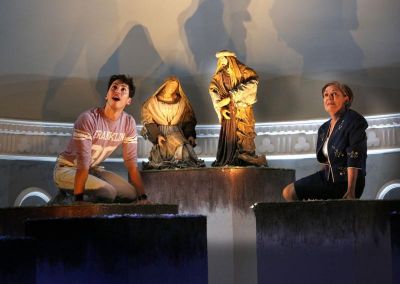Good Works
If only Australian plays were revived more often. This production of Good Works, written by Nick Enright in 1995, proves the value of our own storytelling on stage. It’s not the most powerful play in dramatic terms but it resonates strongly. The story is completely engaging throughout, even though it’s complicated, fast and sometimes difficult to follow.
From before the Second World War through to the 1980s, Good Works traverses three generations of two Australian families: the Donovans and the Kennedys. They live in a small country town, where people use gossip as a tool in a fight. Intolerance is commonplace and cruelty often the key to survival.
Six actors play various parts, crossing back and forth through time. Enright seeks to explore themes unhindered by chronology or other conventions of the stage. Scenes blend into one another; at one point, two scenes are played over each other.
The play is essentially a set of memories that Tim Donovan (Stephen Multari) confronts as he looks back at his relationship with a childhood friend, Shane Kennedy (Anthony Gooley). Both boys struggle to grow up within the limits of their fragile families, which threaten to be torn apart by secrets.

Multari and Gooley’s performances are skilful, grounding this play around its central characters. Some of the other portrayals are even better. Taylor Ferguson (Rita) and Lucy Goleby (Mary Margaret) are vivacious and compelling. Toni Scanlan and Jamie Oxenbould each play various smaller parts but their performances are the biggest of all.
Iain Sinclair’s production is ravishing. Like the play itself, it doesn’t make much sense initially but eventually the meaning hits home. Some previous stagings have helped the audience follow the plot by clearly signalling when each scene takes place. Sinclair has chosen not to do this, which makes it more difficult for the audience, but proves rewarding in the end. It becomes dreamlike and so confusion is acceptable. Indeed, it’s almost like a puzzle: solving it keeps us engaged.
Hugh O’Connor’s set is beautiful: a number of ascending plinths – or stepping-stones – in a field of snow. It’s not easy for the actors to negotiate and they are often divided by distance. But it adds to the sense of dreams and in a clever revelation, the set becomes meaningful in the end too.
Good Worksdoesn’t have a stunning climax but rather, an understated power. It explores an Australian psyche that’s sometimes built out of repression and the protection of certain people and institutions. This is a fine production that proves the power of a well-told Australian play.
Peter Gotting
Photographer: Helen White.
Subscribe to our E-Newsletter, buy our latest print edition or find a Performing Arts book at Book Nook.

